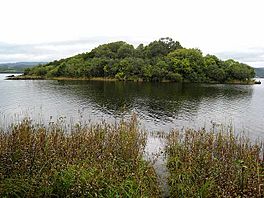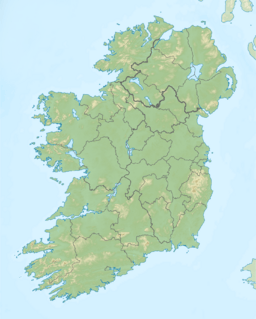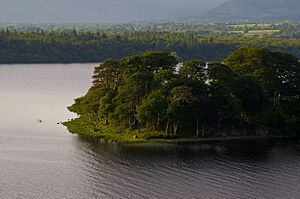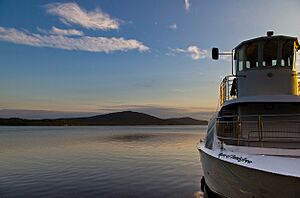Lough Gill facts for kids
Quick facts for kids Lough Gill |
|
|---|---|

Lake and Innisfree
|
|
| Location | County Sligo & County Leitrim, Ireland |
| Coordinates | 54°15′N 08°22′W / 54.250°N 8.367°W |
| Native name | Loch Gile Error {{native name checker}}: parameter value is malformed (help) |
| Primary inflows | Bonet River |
| Primary outflows | River Garavogue |
| Basin countries | Ireland |
| Max. length | 8 km (5.0 mi) |
| Max. width | 2 km (1.2 mi) |
| Surface area | 12.8 km2 (4.9 sq mi) |
| Max. depth | 31 m (102 ft) |
| Surface elevation | 7 m (23 ft) |
| Islands | ~20, including Church Island |
| Settlements | Sligo |
Lough Gill (which means "bright or white lake" in Irish) is a beautiful freshwater lake in Ireland. It is mostly in County Sligo, but a small part is in County Leitrim. This lake is famous because it inspired the well-known poem "The Lake Isle of Innisfree" by William Butler Yeats.
Contents
About Lough Gill
Lough Gill is about 8 kilometers (5 miles) long and 2 kilometers (1 mile) wide. The Bonet River flows into the lake from the east. The River Garavogue then flows out of the lake to the west, near Sligo.
The lake is very scenic, surrounded by thick woodlands. Places like Slish Wood, Dooney Rock, and Hazelwood have popular walking trails. These trails offer amazing views of the lake. The wooded hills of Slieve Killery and Slieve Daean stand tall on the south side of the lake. Lough Gill is also a great spot for birdwatching.
Unique Wildlife
Lough Gill has a special climate, which means it's home to many rare plants and animals. It is a "Special Area of Conservation" (SAC). This helps protect its unique habitats and species.
For thousands of years, the area around the lake was covered by mixed forests. A special tree called the Strawberry tree (Arbutus unedo) grows here. It's usually found in warmer, Mediterranean places. But in Ireland, it can grow up to 15 meters (50 feet) tall! Its Irish name is caithne.
The woods around the lake have many oak, rowan, and willow trees. The lake's shores also support other rare plants. These include yellow bird's-nest, lady's mantle, and bird's-nest orchid.
The lake is also home to several rare or protected animals. You can find sea lamprey, river lamprey, and brook lamprey here. There are also white-clawed crayfish, Atlantic salmon, and otters. The lake system is known for its early run of spring salmon.
Small groups of common terns nest on the lake's islands. You might also spot kingfishers flying over the water.
Islands of Lough Gill
Lough Gill has about 20 small islands. The most famous is the Isle of Innisfree. This island was made famous by William Butler Yeats's poem. Other islands include Church Island and Beezie's Island. People lived on Beezie's Island until 1951.
History of Lough Gill
Long ago, people in the area had a saying. They called Lough Gill a "Grianán," which means "sunny place." This shows they thought it was a place of great natural beauty.
In the early 1600s, Parke's Castle was built on the north shore of the lake. It was a fortified house built by Captain Robert Parke. It stands on the spot where an older tower house of the Uí Ruairc clan once stood. The Uí Ruairc clan ruled this area for many centuries.
Activities and Events
Lough Gill is a popular place for activities. It hosts the Lough Gill 10 km Swim. This is an annual event that raises money for the North West Hospice in Sligo. It started in 2011 and has raised a lot of money for a good cause.
Did you know that Captain Matthew Webb trained in Lough Gill? He was the first person to successfully swim the English Channel. He was a friend of W.B. Yeats's grandfather, who lived nearby.
Images for kids









